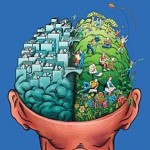 My son likes to watch Mr. Bean, which is a little worrisome for me, as I do not believe in ‘harmless and silly fun’. While good humor and puns certainly stimulate your brain-cells (aka neurons), I think that part of the reason people are amused by Mr. Bean, Charlie Chaplin (or any of the situation comedy heroes who are typically getting into trouble because of their stupidity) is because watching such shows offers them comfort and relief in the knowledge that some other person can be dumber than themselves – and the feeling of having a relatively higher intelligence is enough to boost their self-esteem and actually make them laugh.
My son likes to watch Mr. Bean, which is a little worrisome for me, as I do not believe in ‘harmless and silly fun’. While good humor and puns certainly stimulate your brain-cells (aka neurons), I think that part of the reason people are amused by Mr. Bean, Charlie Chaplin (or any of the situation comedy heroes who are typically getting into trouble because of their stupidity) is because watching such shows offers them comfort and relief in the knowledge that some other person can be dumber than themselves – and the feeling of having a relatively higher intelligence is enough to boost their self-esteem and actually make them laugh.
The above is just an unproven personal theory, and since I’m not a psychologist by trade, so I will probably not bother to research this idea any further, but that doesn’t stop me from telling my son that “If you watch too much Mr. Bean, your brain will slowly shrink into a pea-brain and you will start acting like Mr. Bean”. I believe it is fair, since he also knows that his brain grows and expands whenever he reads or plays games, so that he can balance the Mr. Bean silliness with some reading or games.
It seems that I am not that far away from the truth, as this recent neuroscience study from Leicester University suggests that we tend to dedicate whole neurons in our brains to a celebrity or even a fictional character. The study involved showing pictures of celebrities like Jennifer Aniston and Oprah Winfrey to test subjects, and detecting the neurons that were fired! After this calibration, it is possible to tell whether a person is looking at a picture of Jennifer Aniston or of Halle Berry simply by monitoring their brain cells.
This phenomenon must have a lot of applications in the Neuromarketing and the Psy-Ops markets, and is definitely the basis for celebrity sponsorships and endorsements, but more importantly, it has implications within our own relatively ordinary daily lives. The next time you sit in front of the TV for a few hours of entertainment, or decide to watch a movie, you might want to assess whether the neuron-to-entertainment-value trade-off is worth it for you before giving away a few more precious neurons in your brain. Of course, if you don’t intend to use all those extra neurons, then you don’t really need to watch what you are watching.
So what kind of neurons are you growing in your brain, and what kind of stuff is your head filled with? If you can spare a few, please stare at my avatar for 3 minutes without blinking 🙂

 Osama of GreenWhite.org tagged me on FaceBook to describe a metaphor that I would use for ‘hope’. I would have shied away from such an invitation, but since Osama’s objective is to “get people talking” (and hopefully, thinking and doing as a consequence), so I’ll bite and dump my thoughts on ‘hope’ here, but first, the disclaimer.
Osama of GreenWhite.org tagged me on FaceBook to describe a metaphor that I would use for ‘hope’. I would have shied away from such an invitation, but since Osama’s objective is to “get people talking” (and hopefully, thinking and doing as a consequence), so I’ll bite and dump my thoughts on ‘hope’ here, but first, the disclaimer.